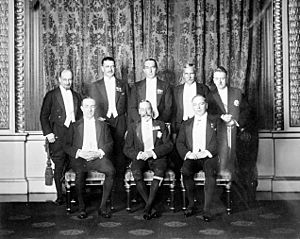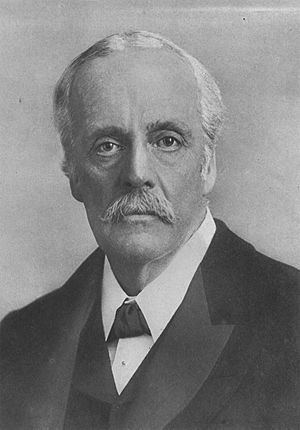Balfour Declaration of 1926 facts for kids

The Balfour Declaration of 1926 was a very important statement. It was made by the leaders of the British Empire at a big meeting in London. This meeting was called the 1926 Imperial Conference.
The declaration was named after Arthur Balfour. He was a high-ranking British official at the time. This declaration changed how the United Kingdom and its "Dominions" worked together. Dominions were countries like Canada and Australia. They were part of the British Empire but governed themselves.
The declaration said that the United Kingdom and the Dominions were:
... independent countries within the British Empire, equal in standing. They were not controlled by each other in their own affairs or in dealing with other countries. They were connected by their loyalty to the Crown (the King or Queen) and freely joined together as members of the British Commonwealth of Nations.
Contents
What Was the Balfour Declaration of 1926?
The Balfour Declaration of 1926 was a key moment for the British Empire. It officially recognized that Dominions were becoming more independent. These countries had fought alongside Britain in World War I. After the war, they wanted more control over their own decisions.
Who Created This Important Document?
A special group called the Inter-Imperial Relations Committee wrote the declaration. Arthur Balfour was the head of this committee. All the prime ministers from the British Empire agreed to it on November 15, 1926.
The idea for the declaration came from two prime ministers. They were J. B. M. Hertzog from South Africa and William Lyon Mackenzie King from Canada.
How Did It Change Things?
The declaration accepted that Dominions were gaining more political freedom. It also suggested a big change for the "governors-general." These officials represented the King in each Dominion. Before, they also acted as Britain's representative to that Dominion.
New Roles for Representatives
The declaration said that governors-general should no longer represent the British government. Instead, new officials called "high commissioners" would be appointed. Their job would be like that of an ambassador from one country to another.
The first British high commissioner was sent to Canada in 1928. This showed that Dominions were now seen as more independent nations.
What Happened Next?
The ideas from the 1926 Imperial Conference were repeated in 1930. They were then made into a law called the Statute of Westminster 1931. This law was passed in December 1931.
The Statute of Westminster
The Statute of Westminster made the Dominions even more independent. It stated that the British Parliament could not make laws for a Dominion. This was unless the Dominion's government specifically asked for and agreed to that law. This was a huge step towards the Dominions becoming fully independent countries.


